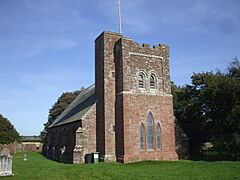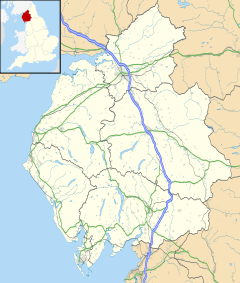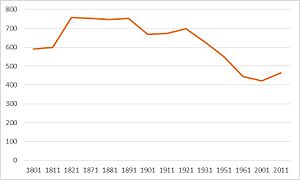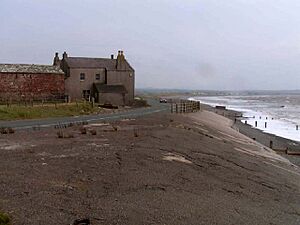Holme St Cuthbert facts for kids
Quick facts for kids Holme St Cuthbert |
|
|---|---|
 The church at Holme St Cuthbert, constructed from local sandstone. |
|
| Population | 465 (2011) |
| OS grid reference | NY104470 |
| Civil parish |
|
| Unitary authority |
|
| Ceremonial county | |
| Region | |
| Country | England |
| Sovereign state | United Kingdom |
| Post town | Maryport |
| Postcode district | CA15 |
| Dialling code | 01900 |
| Police | Cumbria |
| Fire | Cumbria |
| Ambulance | North West |
| EU Parliament | North West England |
| UK Parliament |
|
Holme St Cuthbert is a small village and civil parish in Cumbria, England. It is about 23 miles (37 km) southwest of Carlisle, which is Cumbria's main town. Historically, this area was part of the county of Cumberland.
Contents
Exploring the Holme St Cuthbert Area
The civil parish of Holme St Cuthbert is a countryside area. It includes the village of Mawbray and several smaller communities called hamlets. These hamlets are Aikshaw, Beckfoot, Cowgate, Dubmill, Edderside, Goodyhills, Hailforth, Jericho, New Cowper, Newtown, Pelutho, Plasketlands, Salta, and Tarns.
The parish has borders with other areas. To the north is Holme Low, and to the east is Holme Abbey. To the south, it borders Allonby along a small stream called the Black Dub. To the southeast, it meets Westnewton. On its western side, the parish touches the Solway Firth, which is an inlet of the Irish Sea. This means it has about four miles (6.4 km) of coastline.
How Many People Live Here?
In 2001, there were 421 people living in Holme St Cuthbert. By 2011, this number had grown to 465 residents. This was an increase of about 10.5% in ten years. Even with this recent growth, the population is still much smaller than it was in the past. For example, in 1871-72, about 821 people lived here. The population then slowly decreased until around 1961.
Life in Mawbray
Mawbray is the largest village in the parish and acts as its main community hub. The village hall in Mawbray is a busy place, used for many different activities. The Lowther Arms, a local pub in Mawbray, is also a popular spot for people to eat and drink. It reopened in 2014 after being closed for a few years.
A Look at History
The parish, which was once known as a "township," covered a large area of land. Much of this land was owned by Holm Cultram Abbey. In 1814, some common land was "enclosed." This means that land that everyone could use was divided up and made private. Before 1857, Holme St Cuthbert was part of the larger Holme Cultram parish. It was known as "St Cuthbert's township" and was centered around Mawbray.
During the Second World War, 43 children and families were sent to farms in the parish. These were evacuees from Newcastle-Upon-Tyne and nearby areas, moved for safety during the war.
Local Government: The Parish Council
Like many areas, Holme St Cuthbert has a parish council. This council helps make decisions for the local community. In 2018, there were seven members on the council. They usually meet several times a year to discuss local matters. There is also an Annual Parish Meeting where the council updates the community on their work. Since 2016, you can find records of their meetings online.
The Holme St Cuthbert parish council has spoken out against plans to store nuclear waste in west Cumbria. They were worried about the local geology, how it might affect tourism, and safety. The council felt they might not be able to stop the process once it started.
Protecting the Coastline
While extreme weather is rare, the sea can be a danger. With four miles of coastline and a main road (the B5300) running very close to the shore, storms and high tides can cause problems. In 2014, the sea wall at Dubmill Point was damaged. Repairs costing £130,000 were needed to fix it.
Between November and December 2018, a public discussion called the Cumbria Coastal Strategy took place. This was to look at and manage risks like coastal flooding and erosion along the Cumbrian coast. The coastline around Dubmill was thought to have about five to twenty years of protection left. There were also concerns about damaged sea defenses to the north and south of Dubmill point.
The study also looked at how coastal erosion might affect Mawbray village. The sand dunes at Mawbray Bank could erode by 4 to 8 meters in the next 20 years. This could increase to as much as 40 meters in the next century if nothing is done. At Beckfoot, most erosion happens during big storms, not slowly over time. Over the next century, the coast at Beckfoot is expected to erode by no more than 6.6 meters.
The Village of Holme St Cuthbert
The village of Holme St Cuthbert itself is quite small. It is home to the parish church, a church hall, and the local primary school. There are not many houses in the village. The school has two buildings: a main one and a smaller one used for sports and as a canteen. A car park, shared by the school and church, separates the two buildings.
St Cuthbert's Church was built in 1845 using local sandstone. It is still used today. The primary school has less than 50 students but has been rated as "outstanding" by school inspectors Ofsted. When the church opened in 1845, the village became its own parish, no longer part of Holme Abbey parish.
The village is located along a road that connects the B5300 coast road at Mawbray to the B5301 at Tarns. There is also a side road that leads to Goodyhills and Jericho. There are no regular public buses in the village itself. However, a school bus stops here for students going to the Nelson Thomlinson school in Wigton. The nearest regular bus stop is in Mawbray, with buses running every two hours to Maryport and Silloth-on-Solway. The closest train station is at Aspatria, about five and a half miles (9 km) away. Trains on the Cumbrian Coast line run about once an hour.
What's in a Name?
The name "Holme" comes from an old Norse word, "holmr," which means "islet" (a small island). So, "Holme St Cuthbert" means "St Cuthbert's islet." Saint Cuthbert is a famous early Anglo-Saxon saint. He is well-known for his connection to the Lindisfarne Gospels. While he probably didn't visit this specific parish, he did visit Carlisle. He is celebrated across northern England and southern Scotland.





